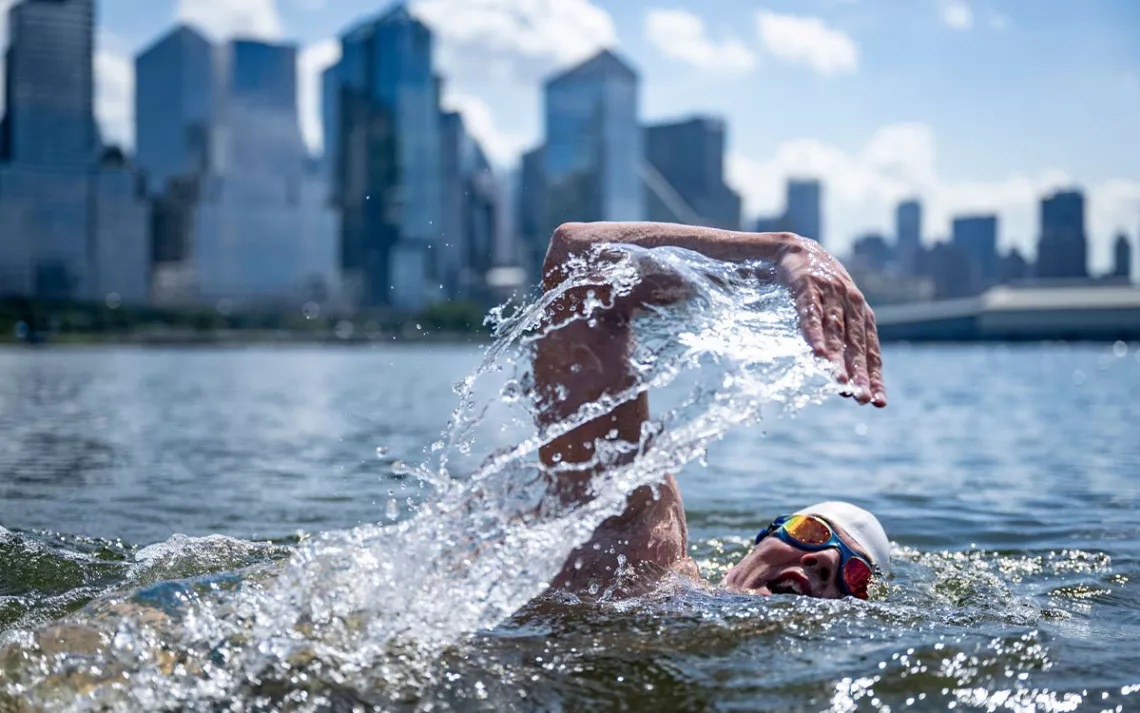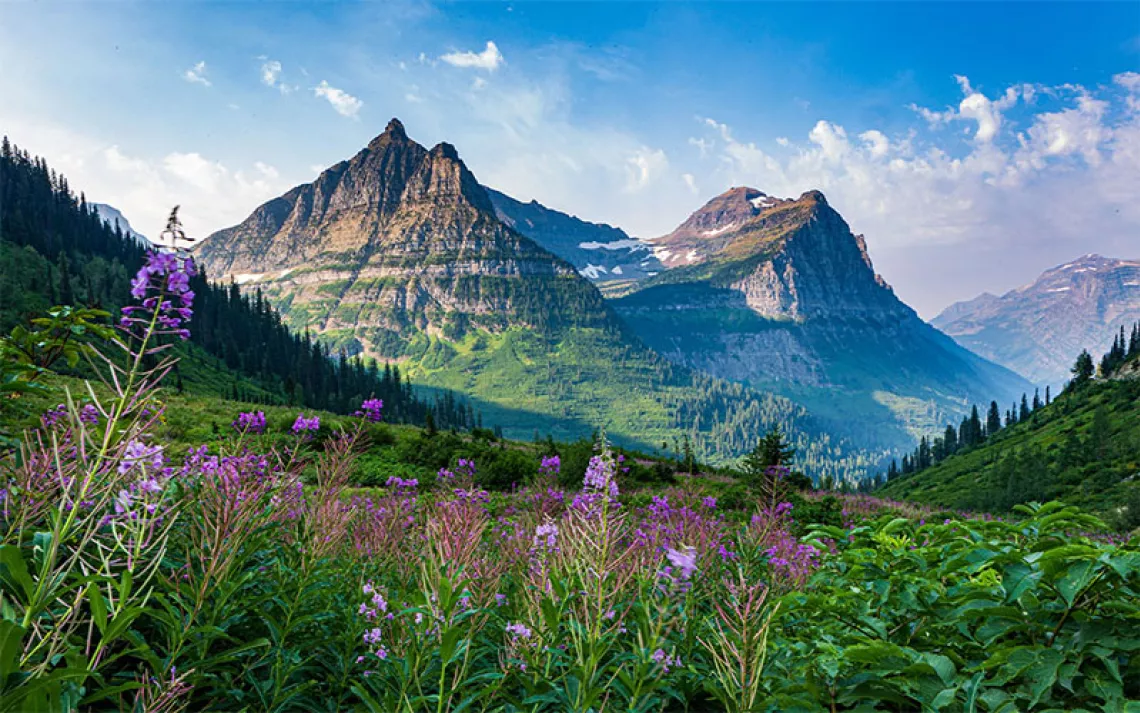These Residents Want a Swimmable Chicago River
Pollution hampers efforts to clean up urban rivers as swimmers seek more recreation opportunities

Lewis Pugh swims in the Hudson River. | Photo by Kelvin Trautman/The Lewis Pugh Foundation
In July, Jessica—a resident of Chicago’s Old Town neighborhood—was faltering in her fundraising efforts, having raised just $250 of the $1,000 in donations needed to swim a mile in a competitive race called the Chicago River Swim. The September 22 event, planned by a local nonprofit organization known as A Long Swim, would have taken place in the Chicago River, which flows through the heart of the city.
When organizers announced the event in April, Jessica secured one of 500 slots and asked friends and family to contribute to the fundraising requirement. Then, a growing amount of press revealing the uncertainty of the event began to dissuade her. The city rejected the organizer's permit. "At that point, I stopped fundraising because it felt weird,” she said, referring to what happened in July when the Chicago Department of Transportation denied ALS their event permit.
"While the City of Chicago recognizes the positive nature of the A Long Swim’s open water event, the proposed route and concentration of swimmers raised significant safety concerns for participants, first responders, and the general public,” Erica Shroeder, a representative from the Department of Transportation, said in a statement. After a month of back and forth, A Long Swim announced it had reached a compromise with city officials. Instead of holding the event in the Chicago River, A Long Swim will ferry participants from Chicago’s Riverwalk to Ohio Street Beach, where they will swim a course in Lake Michigan.
A Long Swim and its cofounder, Doug McConnell, are not the only ones trying to bring swimming back to their long-neglected urban waterways. As city dwellers worldwide seek to reclaim and enjoy their rivers and bodies of water, the specter of pollution, lackluster public opinion, and urban framework that favors industry over recreation pose difficult hurdles. But one thing for certain can be said about open-water swimmers and environmental advocates—they’re tenacious. McConnell has been trying to bring a Chicago River Swim event to fruition for the past 11 years. He tells me his permit was denied this year because of the city’s unease around swimmer and spectator safety—that spectators might feel compelled to jump in at the sight of swimmers in the river. And while that’s one goal of his event, the infrastructure isn’t ready for it.
“In the 100 years since they've had a swim in the Chicago River, they've done any number of improvements to the river itself, but it would appear that there really hasn't been a lot of thought given to having swimmers in and out of the Chicago River,” he said. Though he was prevented this year, McConnell hopes to hold a competitive swim event in the Chicago River next year. “We extracted a promise from various safety departments that they would support a main stem river-oriented swim for next year, and we live to fight another day,” he said.
Where it once flowed into Lake Michigan and contaminated the city’s source of drinking water, the Chicago River now flows away from the lake and connects to the Mississippi River by way of human-made canals and other tributaries. This feat of civil engineering was completed in 1900 and transformed what many considered an open-air sewer and industrial dumping ground into a viable venue for athletic competition, with the first-ever competitive swim event in the Chicago River held in 1908.
While the river experienced additional pollution issues throughout the 20th century, the Clean Water Act of 1972 and the construction of a series of tunnels and reservoirs—known as the Deep Tunnel or Tunnel and Reservoir Plan (TARP) system—have brought about a remarkable turnaround. So remarkable that in 2015 the Illinois EPA approved sections of the Chicago River for recreational activities, including swimming.
“When I was a lad, it really was an industrial waterway,” McConnell said. “It's a huge success story for the city, and what a way to celebrate it.”
He’s not alone. In June, more than 150 people jumped into the Patapsco River at Baltimore’s Inner Harbor. The event, dubbed “Harbor Splash,” was organized by the Waterfront Partnership of Baltimore, a nonprofit dedicated to the vitality of Baltimore’s waterfront spaces. Farther south, swimming in the Potomac River in Washington, DC, has been illegal since 1971 due to pollution, but several advocacy organizations are calling for a lift on the ban as water quality continues to improve.
Some of the most publicized instances of urban swimming happened at the Paris Olympics this summer, where the Seine River took center stage as the venue for triathlon and open-water swim events. Because of pollution levels, swimming in the Seine River has been illegal since 1923, but over the past four years, leaders in Paris invested $1.5 billion in cleaning it up.
Whether or not their efforts worked is still up for debate. At the start of the Olympics, triathlon training events meant to familiarize athletes with the course and conditions were canceled, and the men’s triathlon event had to be postponed as bacteria readings of the Seine repeatedly showed unsafe levels, according to World Triathlon’s water safety guidelines. It wasn’t until later that week that bacteria levels had dropped to acceptable levels, and the women’s triathlon took place as scheduled, with the men’s immediately following. After competing in the event, 30-year-old Jolien Vermeylen of Belgium told Flemish television outlet VTM: "While swimming under the bridge, I felt and saw things that we shouldn't think about too much.”
“It wasn’t perfect, but the investment [Paris] made really tells the world that this is important,” said Margaret Frisbie, executive director of Friends of the Chicago River, a nonprofit organization “working to improve the health of the Chicago River system for the benefit of people, plants, and animals.” Just before the Olympics, Friends of the Chicago River was among 56 other organizations from 17 countries to participate in the launch of the Swimmable Cities Charter. This document asserts that swimming is a right for all people, and that “swimmable urban waterways are vital to the livability of cities and communities.”
Access to swimmable water in urban areas is more important now than ever, as public pools across the US go underfunded and the heat island effect exacerbates warming trends in urban areas. A 2023 study showed that some neighborhoods of Chicago, DC, New York, and San Francisco were consistently more than 10 degrees hotter than less populated areas, with communities of color bearing the worst of the heat.
“We need places where people can go to have relief from heat,” said Frisbie. “If you want livable cities, you have to offer people all of the things that make life good and healthy, and having accessible rivers is a component of that.”
While Chicago residents continue to make strides toward an accessible river free of pollution, rainfall, which washes bacteria into waterways, is still an unpredictable threat. “You have to understand where bacteria can be coming from,” said Tom Minarik, principal environmental scientist at the Metropolitan Water Reclamation District of Greater Chicago. “Wastewater effluent (sewage) is one of those sources, but stormwater runoff is another one.” Minarik and his team monitor the water quality throughout the Chicago–Calumet River system via 30 active monitoring locations. They collect data on temperature, pH, dissolved oxygen, ammonia, nutrients, fecal coliform bacteria, mercury, phenols, and chloride, to name just a few. The data is then reported to the Illinois Environmental Protection Agency, which upholds Chicago River water quality standards.
“The people that are organizing this swim event, they’ve asked for our data, and we’re sharing what we can, but we’ve made it very clear that we only measure the fecal coliform count once a month in the Chicago River main stem, so it’s not a lot of information,” Minarik said. “The standard method to measure fecal coliform units, it takes 24 hours to get results. So if you take a sample now, you're really not going to know until tomorrow what the actual fecal counts were.”
H2Now Chicago is a monitoring pilot program attempting to solve this information lag. It uses state-of-the-art sensors to produce fecal coliform readings every 15 minutes and aggregates data from three-hour averages to do something never done before: formulate forecasted water quality several days into the future.
“The good news about the technology from H2Now is it's really real-time,” McConnell said. “And as a data provider, it’s indispensable for our decision-making about whether or not to put swimmers in the water.”
Upon hearing the news of the updated course for the Chicago River Swim, Jessica said she’d likely defer her event entry until next year. But as time passes, her enthusiasm for a swim in the river has waned. “A lot of people, when I told them about this [Chicago River Swim], were like, ‘yuck,’” said Jessica. “At first, I wasn’t worried about it, but then other people who were signed up were like, 'I’m going to be taking antibiotics,'” she said.
Despite the challenges, Frisbie is all for a Chicago River swim event. “People push back against change, and they won’t really believe it's possible, but when they see it, then they start to believe it,” she said, speaking on Chicagoans’ shifting opinions of their river. She reflected on a scene she witnessed on a summer day a few years ago, of children laughing and playing as they jumped in and out of the water at the Chicago River’s North Branch, where it runs through a nature preserve nestled beside the Eden’s Expressway. She sounded almost wistful as she remembered. It made the determination in her voice understandable as she spoke again on a Chicago River swim: “The fact is it’s totally workable. You just have to have the mindset that it’s worthwhile.”
 The Magazine of The Sierra Club
The Magazine of The Sierra Club



